-
this old house: my life in a highly permeable membrane
My house breathes. That’s not the technical term for it, of course – the technical term is that it has “excessive air infiltration.” I had an energy efficiency audit last week that confirmed it. Jim from the energy utility here in Austin hooked up a blower door to my entryway and let it rip. The blower door has a red piece of canvas with a big fan in the center that covers your front doorway. It looks like it would be used to inflate a circus tent but it’s the opposite. It sucks all the air out of your house and then tests the pressure. Well, at least it tries to – my house gave it a good run for its money.
Jim told me the appropriate level of seal for an energy efficient house in this climate would have to be less than 5 air changes per hour, or ACH, for those trying to quantify energy hogs like me. (He also told me that’s measured at 50 pascals of pressure, which I’m passing on to you, dear reader, because it means nothing to me.) The little computer attached to the blower reported that my house had 35 ACH. Was this the worst he’d ever seen? No, but he did later make a casual comparison between my house and a tobacco drying barn, a structure purposely built for open ventilation.
When Jim hooked that thing up there was air streaming out of the shiplap in the walls, out of the corners of the ceiling and out of the cracks in the floorboards. Don’t even mention the 1930’s back door it took me three weeks to find. It fits perfectly with the aesthetic of the house, if not the specific doorframe it has come to inhabit. Morning sunshine regularly shimmers through its top and bottom edges, along with the heat or cool of the season. With that blower going, the interior of my house turned into a 3D foosball table – all Jim and I needed was a puck and some paddles and we would’ve had a Matrix-style parlor game.
As a sometimes epidemiologist I’m all for quantification, but I didn’t need the fancy machine to tell me there was the occasional gap in my house’s enclosure. In the old days, before the wavy glass windows were replaced with modern Low E vinyl-encased panes that actually closed, I used to sit reading on the couch as wisps of wind would whip wisps of my hair from behind my ear, tickling my cheek. During the ice storm of 2007 there were such gale force winds coming from the kitchen and living room that at night I had to seal my bedroom door with plastic sheeting, pile three down comforters on my bed and sleep with my slippers on.
When I moved into the house in 2006 there wasn’t a stitch of insulation in the place. Wait, I take that back. Several excavations necessitated by live termite infestations revealed multiple rats’ nests (we’re talking several shop vac-fulls worth of materials) in the walls and under the floorboards. All that rat coziness must have translated into some shared insulation, right? The walls that weren’t full of gray nest matter were loaded to the brim with pecan shells discarded by the resident attic squirrels. Once my carpenter even found a small cast iron frying pan like the cowboys must have cooked breakfast in out on the range. So, there was insulation, it just wasn’t the kind you buy at Home Depot. I like to refer to it as “organic.” The lack of traditional insulation was only one of many challenges this near-condemned property presented me with starting from before it was even mine.
After the pre-sale house inspector spent the day poking into every corner, he told my realtor and me to sit down to hear the results. As she and I balanced on the arms of the only piece of furniture – a pink velveteen Barka lounger – he proceeded to announce a list of house ailments that ran several pages long. If the house had it, there was a problem with it. If the house didn’t have it, that was also a problem. I could tell the realtor was gearing herself up to give me a pep talk but it wasn’t necessary. I knew what he was saying wasn’t good, but after my few years in Africa I was so focused on the relative luxuries the house would offer that I wasn’t fazed by his doomsday laundry list.
I’d been conducting my own assessment that day: No rats will climb up my mosquito net while I’m sleeping! I won’t have to strobe lamp my flashlight and stomp and scream for 3 minutes to scare away the cockroaches before I use the latrine! The bat shit won’t drip onto my clothes on the top shelf! No references to rusting pipes, a leaking roof and matchbook shims could dissuade me from the feeling that this was a step up.
In fact, instead of scaring me away, all of these problems endeared me more to the property. This worn out, working-man’s Depression-era house seemed the perfect bridge between the rustic African field life I was coming from and the new American life I was starting. The supermarket cereal aisle was culture shock enough, moving into a hermetically sealed, white-picketed show house would’ve been too far a leap.
As it turned out, my time in Africa had uniquely prepared me for the inconveniences of the fixer- upper. In my second month, the kitchen sink broke – I can’t remember how or why now – so I shifted the dish washing operation to the shower. It didn’t seem so different than carrying the washing bucket to the dirt-floored women’s bathing area I’d been using in Congo for my nightly scrub down. When the plumber finally came he asked me how long I had been living “like this,” meaning with plates stacked up on my bath mat. Three weeks, I told him. He looked at me with a mixture of alarm, pity and admiration. “My wife would’ve never put up with that shit,” he said, shaking his head. I didn’t know whether to be proud or ashamed.
Soon after came the discovery of the live termites, yet another link between my life in Texas and my life in Africa.
One night in Darfur, after the first rains in months, the house my team was living in was swarmed by flying termites. We’re not talking a few curious visitors flitting around the lantern. We’re talking air so thick you can’t even see the lantern. The floor beneath our picnic table was alive with three-inch deep glossy brown writhing insect bodies. There was no amount of Off or roach killer we could spray to make a dent in the influx. We just had to sit back, tuck our jeans into our socks and try to convert our visceral disgust into marvel at amazing mother nature.
Now, there are a few important differences between the respective Austin and Darfur infestations that are important to point out. The main divergence centered around money and cuisine. Whereas in Darfur the house cleaner took care of the termite carcasses the next morning as part of her daily duties, here in Austin I had to pay thousands of dollars to the exterminator, the carpenter, the dry wall guy and the lumber company to replace the front of my living room. But on the bright side, here in Austin none of the actors involved served me up a plate of fried insect for lunch.
When I said that the cleaning lady “took care of the termite carcasses” I’m sure you imagined a broom and a garbage bag. No. The termites were indeed swept up but not for the garbage. The cleaning lady, the cook, the laundry woman and the guard’s wife spent the entire morning scooping up each and every termite – buckets and buckets full – and then spent the rest of the afternoon frying them with glee. Fried termites, as you’ve probably seen Anthony Bourdain exclaim in various far flung locales, are a delicacy in many places, including Darfur. I politely declined (as politely as possible when one’s face is squinched up trying to mask culturally insensitive horror) and ate an expired Cliff Bar from the bottom of my duffel bag instead.
Another way my house brought me closer to Africa was through the wild back yard. When I bought this fixer-upper I started a to do list of projects that will most likely outlive my residence in this house (and quite possibly on this earth.) The foundation work, roof and re-pipe had to be done immediately. And there went the budget to do anything else. Once the emergency items were ticked off, when time and money have allowed, I’ve occasionally been able to tackle other projects with the help of my family, friends and a particularly handy ex-boyfriend.
One to-do that hasn’t been touched is landscaping the back yard. If Jose from across the street doesn’t come to weed whack once in a while it gets real jungly back there. So jungly, in fact, that my Congolese refugee friend asked if she could grow her beloved African squash in the center patch – my back yard reminded her of her native Congo where the plant grew very well. Nanyuria spent the next afternoon preparing before she planted. Working on a deadline in my office that overlooks the back yard, I watched her pick and prod the soil with her baby strapped to her back and was immediately transported to North Kivu. I had spent the six months before I moved to Austin there, watching women pound the soil into submission and then harvest their greens and squashes for their families’ daily meal as I interviewed them about their babies’ health.
All these experiences have helped ease the disconnect I usually feel when I bounce back and forth between the two worlds. Before I had this house it was Africa all or nothing; since, there’s been a steady sprinkle of Africa right in my backard. My permeable membrane house played a big part in that.
On his visit, Jim told me that in a couple months the contractors will come to seal all of my gaps. In the name of energy efficiency, they’ll go from room to room with their foam sprays, caulk guns and weather strips trying to keep more of the outside from encroaching on my inside. This will mean I won’t sweat so much when I type at my computer in the southeast corner of the house with the pounding afternoon sun. This might also mean the pollen-drenched pecan flowers won’t float in through the crack underneath my kitchen door giving me and the dog uncontrollable sneezing fits. And, my ACH will get closer to the target range, giving the blower door less to blow out. But there will definitely be some character loss with my energy efficiency gain – the difference between “here” and “there” will grow more distant and my ramshackle bungalow will be less of a bridge and more of a fortress.

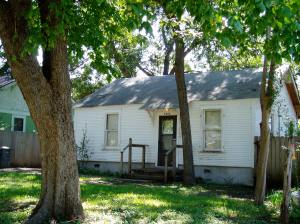
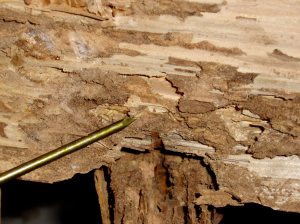

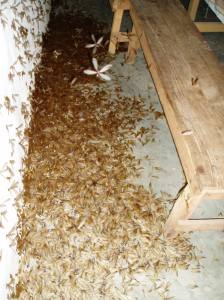
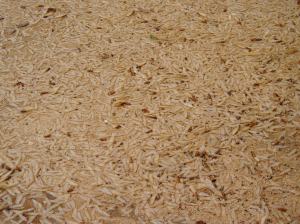

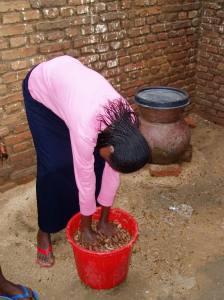



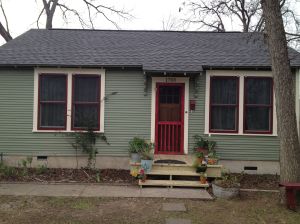




Sitting here reading this at a cafe in Botswana in the sun… thinking about you and your little house and the necessity of permeability:)
I don’t think we could top Zamfara for permeability of barriers social and structural. Wish I was there in Botswana with you to devise clever rat traps!